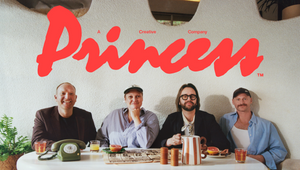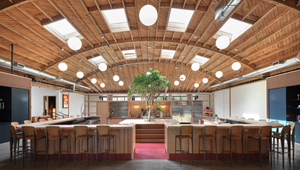
For Kate Stanners, “Film Is The Reigning Medium”

Kate Stanners, chairwoman and global chief creative officer at Saatchi & Saatchi, is this year’s jury president for the Film category at Cannes Lions.
Prior to Saatchi & Saatchi – where Kate has worked for the past 18 years – she set up the communications company, Boy Meets Girl, and in 1995 she was a founding partner of the ground-breaking agency, St Luke’s which became famous for its revolutionary working practices and progressively-oriented work. She is a member of WACL – an association for the most influential women in the UK communications industry.
The Film Lions celebrates the best of the moving image and Kate states that, despite all the industry changes, it remains “the reigning medium.” It was the only award at the inaugural Cannes Lions in 1954 to honour, celebrate, and inspire excellence in filmic advertising. Over time, the category has evolved to incorporate new forms of film, like digital, and new formats too while continuing to set the standard for what ‘great’ in the category can and should be.
LBB’s Zhenya Tsenzharyk caught up with Kate to learn more about her expectations for the category this year, her views on humour and purpose at Cannes Lions, and predictions for the festival’s biggest talking points.
LBB> Kate, how are you preparing for the jury room this year? Do you have any guiding principles or anything you want to say to the jury before the judging begins?
Kate> I’ve just completed my prejudging, so that’s a good scene-setting exercise, it gives a good benchmark. What I have said to the jury in this pre-stage is be generous – if you think it is interesting but not sure, that way the work can make it through to the conversation, and for me that’s important. Regarding the criteria, of course you are always looking for originality. In many ways you are looking for industry benchmarks which will become a reference for years to come.
LBB> What did you make of last year’s Grand Prix winners: ‘WoMen’s Football’ for Orange and ‘Play It Safe’ for the Sydney Opera House?
Kate> I loved both of these. As a film jury we are unique in that we have two Grands Prix to award. These demonstrate why. The amazing craft of both are designed to be viewed in very different ways.
LBB> Film is one of the most prestigious categories at Cannes Lions yet it’s no longer the reigning format for advertising amid an explosion of mediums and integrated campaigns. With this in mind, how do you define excellence in film advertising today
Kate> I disagree. Film is the reigning medium. Even digital outdoor will use film, and how do we submit our ideas now? With a case film. Film is how we communicate and tell our stories. We have many channels available to us and many ways to fill them. The trick is in understanding what is right, for when and to whom; 6-second social requires different film making to a 90-minute documentary. I think film is the perfect intersection of idea and craft. It is incredible how you can start watching something that feels relatively ordinary, and it can draw you in with the directing, the writing, the performance, the sound the editing …and suddenly good is great.
LBB> What trends or shifts in film advertising are you hoping to see reflected — or challenged — in this year’s entries?
Kate> You always want to see new ways of playing with the format. We are seeing how AI is being integrated into both the ideation and production processes, so I think that is evolving. I believe the best film touches us in an incredibly human way. There is an empathy that creates connection. Humour is a good example, it is so idiosyncratic, deeply human and creates a powerful human connection. That’s an example of what human creativity can bring to the AI party.
LBB> How will you approach judging while evaluating work from different regions and cultures to ensure that all films are judged without unconscious bias?
Kate> This is what makes Cannes Lions so wonderful, seeing work from everywhere. I try to be respectful of the different types of ‘great’ according to cultural context, taste and style. There are categories specifically to shine a light on local insight driven work. In the submissions there are background notes and yes, even in film there can be a supporting case study film to help. Cannes Lions are also great at providing local knowledge and expertise to support the process. And then there is the jury, not only chosen for their excellent creative credentials, but also for their diversity.
LBB> Humour was one of the biggest themes of last year’s festival. Will you be looking out for the humorous side of filmmaking this year too?
Kate> Cannes introduced humour as a category to encourage us to make more funny stuff. It felt like the craft of writing and directing comedy was disappearing. It is one of the hardest things to do. It can also be polarising, and locally nuanced, which might account for there being not much of it. However, maybe because of the world we are living in, I am seeing more, which is great .Some totally crazy stuff, some just brilliantly performed pieces of timing, and some that are wonderfully written.
LBB> AI started to creep into film last year and it’s likely to be present this year. What’s your view on it and on what grounds will you be judging with your fellow jurors?
LBB> Practically, entries are asked to identify where AI has been used in the process as an FYI. AI is no longer an idea in itself; it is an integrated tool.
How we collaborate with it is what is interesting. People talk about AI as if humans have nothing to do with it. The meeting of human intelligence, or instinct, analytical intelligence and artificial intelligence is what we are seeing.
LBB> In your career, you’ve been known to champion creativity with a conscience – what kind of role should purpose, or social impact weigh in on a film’s merit at Cannes
Kate> We have seen award shows flooded by purpose-led work, and maybe that is a reflection that creativity was not being pushed in some of the more product-led communications. I think when brands properly get behind a cause, that is powerful. Not just because NGOs, charities, social and environmental causes need their support to have meaningful impact, but also because a brand’s values and actions are judged by their consumers. When so many products can be so similar, a brand that supports a cause that connects with our values will make us more inclined to buy it.
What I don’t like are projects that feel like they have been done for awards.
LBB> What do you think will be the big talking points of the festival this year?
Kate> If AI can make good enough work, what does great look like?
The convergence of AI and humanity.
Human creativity often breaks the frameworks and boundaries that Ai operates in. Humans are great at taking tech and using it in ways that it was never intended to be used. That's progress.
LBB> What are you looking forward to doing at Cannes outside of the jury room?
Kate> The community. Old friends and making new ones. The conversations fuelled by inspiring work and a shitload of rosé. What’s not to love?
See more of LBB’s Cannes Lions 2025 jury president interviews in our collection here.















